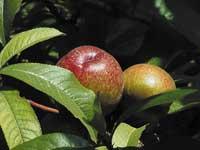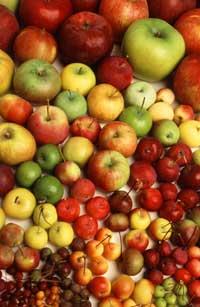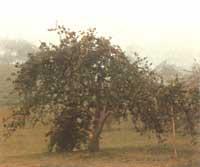Cider on examination
2002/11/01 Andonegi Beristain, Garazi - Elhuyar Zientziaren Komunikazioa Iturria: Elhuyar aldizkaria
Several groups in the area of chemistry and microbiology of the UPV are conducting a chemical and microbiological study of cider. With new and more precise techniques is being studied a product so known among us. This research, which was launched two years ago, still has a long way to go.
The cider, known
The research of cider should contemplate the entire production process: analysis of raw materials, follow-up of fermentation and evolution of cider in bottle. The first step is to conduct an analytical study of apples. For this purpose, the nursery apples of the Diputaciones Forales in Zubieta (Gipuzkoa) and Zalla (Bizkaia) have been used: Moko, Txalaka, Goikoetxea and 20 other types. All these apples are considered from the Basque Country, so the apples brought from outside the sidreros have not been analyzed.

Comprehensive analytical studies have been conducted with all kinds of apples. First, the content of sugars, acids and phenols has been analyzed. The main component of apples are sugars, responsible for sweetness, followed, to a lesser extent, by acids, which provide acidity and, finally, in a very small quantity, phenols, responsible for the urination. Then the amount of glucose, fructose, sucrose, etc. in the group of sugars. Its content has been analyzed in acids, tears, quinics, etc. and in phenols the amount of catechin, epicatechin, hydroxycyanidine, procyanidine, etc.
In the second step, a follow-up of the fermentation took place, comparing the normal press with the pneumatic press on the one hand, and on the other hand, the differences between the barrel of wood and the one of steel were analyzed. As well as the influence of different apple mixtures on the final apple. For this purpose, in addition to analytical studies, a microbiological analysis has been carried out. In fact, cider is the drink resulting from a fermentation process, so it contains yeasts and bacteria.
In the last step, the evolution of cider in the bottle has been analyzed, carrying out again analytical and microbiological studies.
Recommendations for the future
After two years of analysis, the researchers have reached the following conclusions: the pneumatic press is better than the traditional press, because it is cleaner and faster. And although there is debate, steel tanks are better than wood, since the temperature is easier to control and are cleaner.
As for apples, it is not advisable to use too much slow apple to obtain the initial must, not too much acidic apple. In the first case, cider is easily lost, while in the second, maturation costs a lot.
Taking into account all these considerations, according to chemical studies, the best option is to use a suitable apple mixture, crush with pneumatic press and in steel tanks, better in the fridges, a cured cider.
Always keep in mind that these are only recommendations and that remains in the hands of the cider decide which apple to use and how to make cider. The aim of the research is to make available to the cider the results with a scientific basis, so that, through their experience and these results, they can produce different types of cider.
- Title of projectApples, musts and ciders.
- Objective Chemical and microbiological analysis of raw materials and fermentation.
- Working group G. del Campo, I. Berregi, I. Santos, M. Dueñas, A. Irastorza, I. Ibarburu, S. Velasco, B. Gallo, F. Vicente, L. A. A. Berrueta, R. M. M. Alonso.
- Applied Chemistry Division, Analytical Chemistry, Microbiology.
- • Faculty of Chemistry of the University of the Basque Country and Faculty of Sciences of Leioa
- Financing: Financing: Gipuzkoa Natural Cider Association, Bizkaia Cider Association, Department of Agriculture and Fisheries, Gipuzkoa and Bizkaia Provincial Council.

Gai honi buruzko eduki gehiago
Elhuyarrek garatutako teknologia





